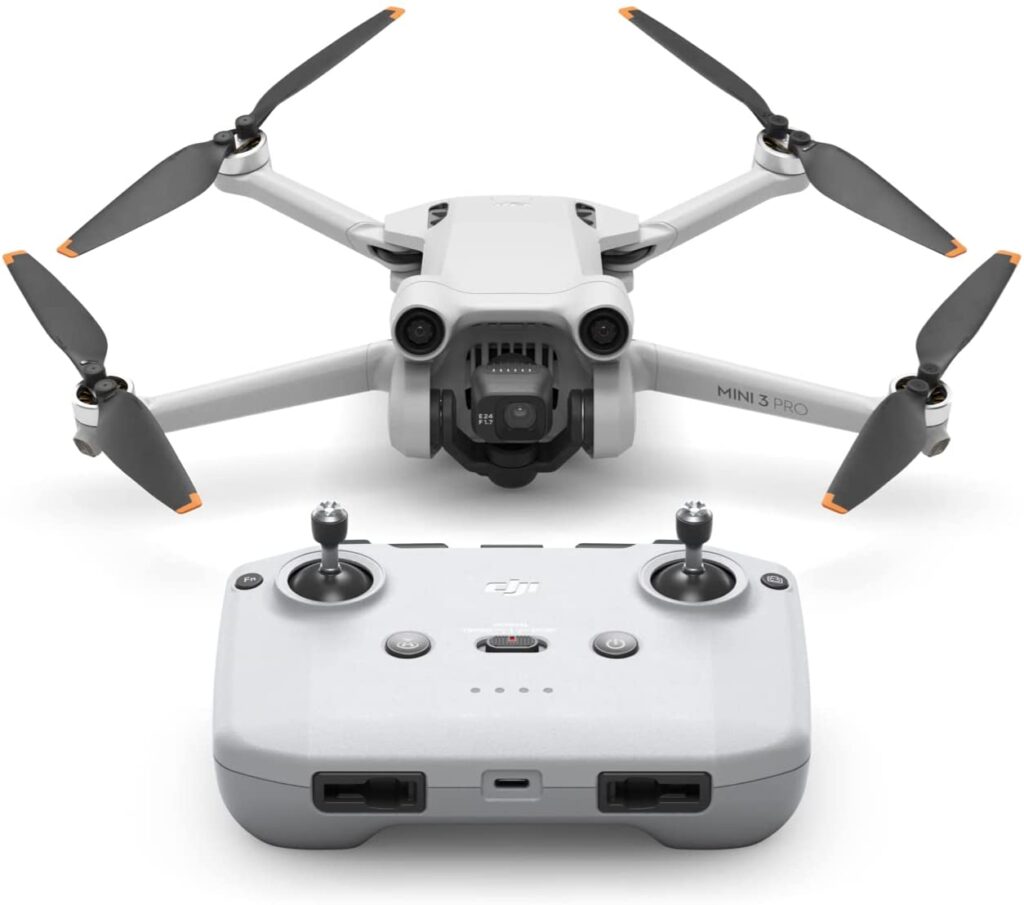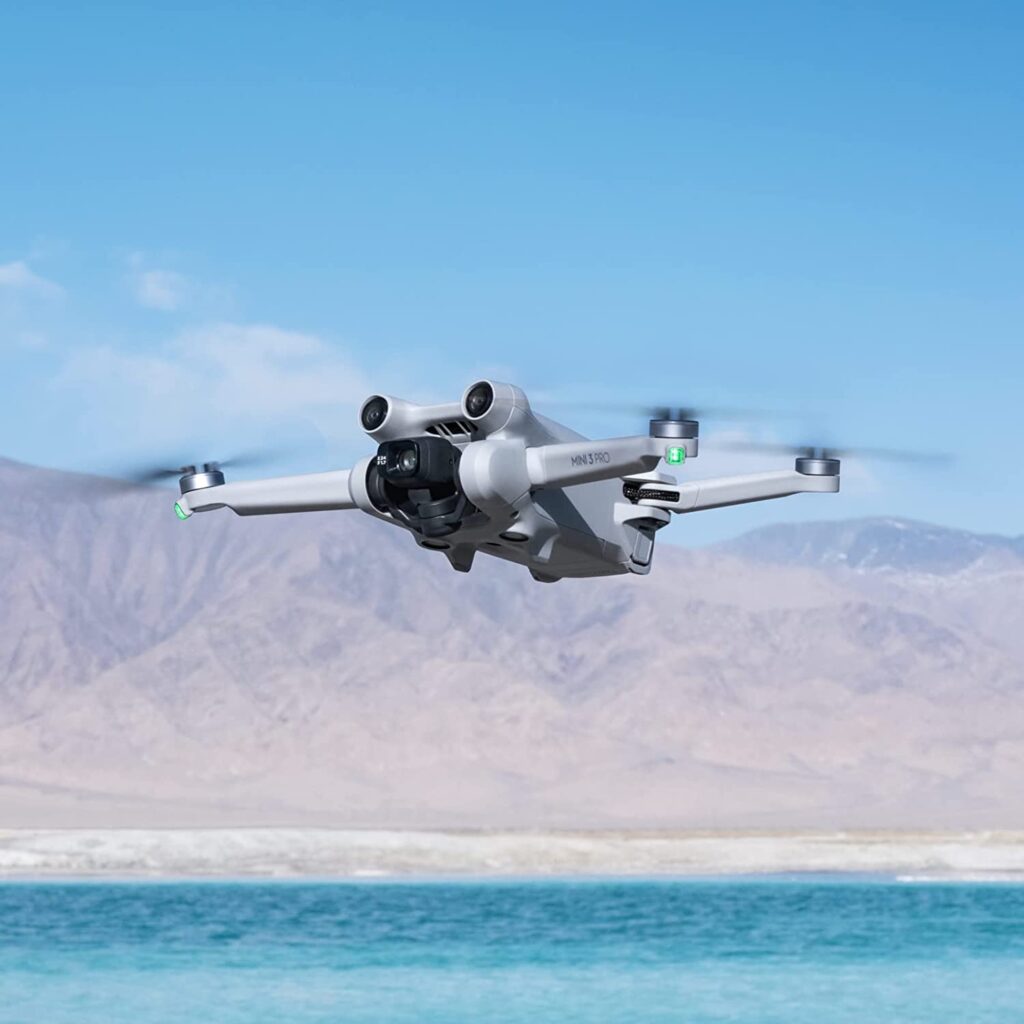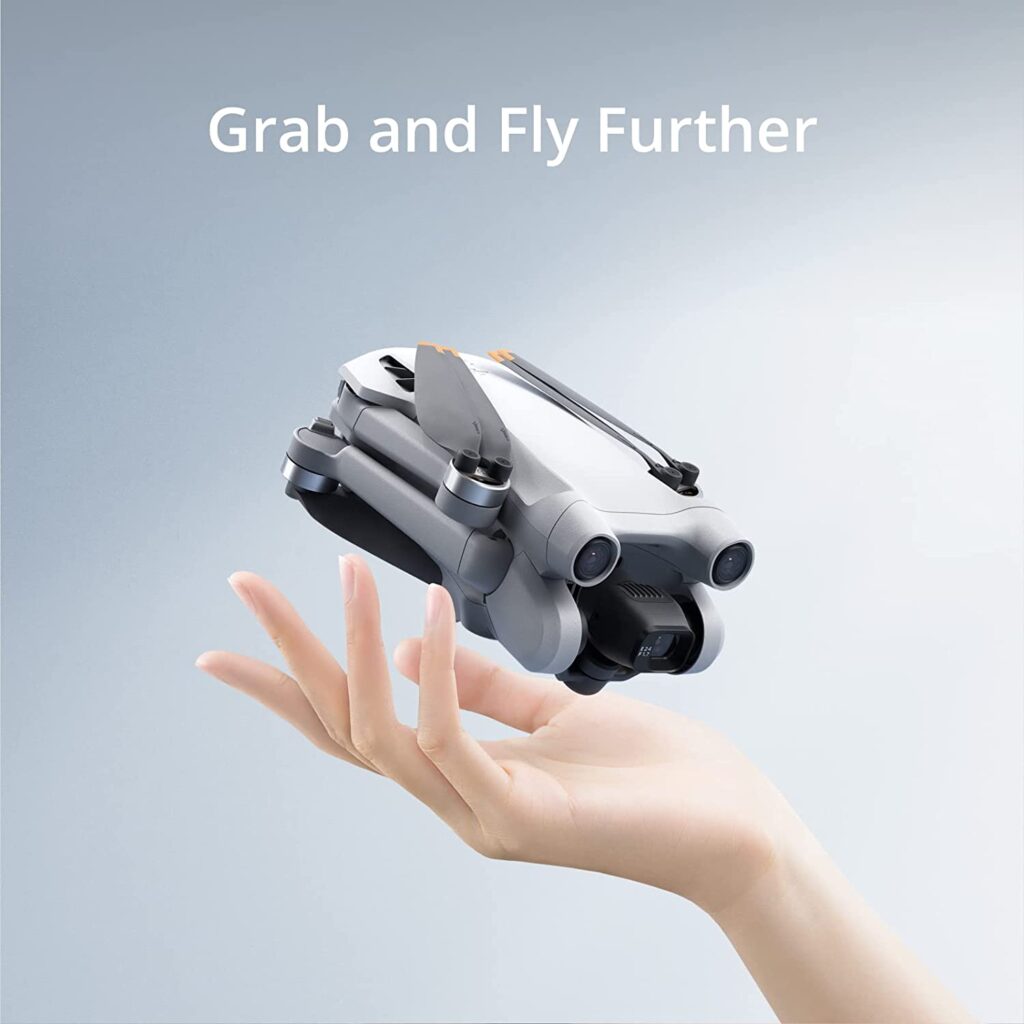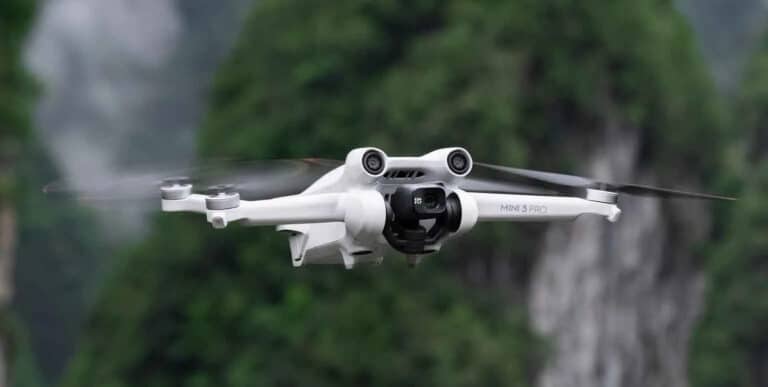The Mini line of drones from DJI has always focused on keeping weight under 250 grams. The rationale for this is to let them be flown in many countries without requiring registration or training. Consumers desire products that can be taken out of the box and flown lawfully with no paperwork or additional expenditures. Previously, buying a Mini meant sacrificing features & – to some extent – quality. Because there’s no obstacle avoidance but no ability to automatically follow a subject until the DJI Mini 3 Pro drone, all of which are common functionality on other DJI drones.
However, you now have all of the functionality of the Mavic Air 2 (plus a few enhancements) and can fly in a lot more areas.
The DJI Mini 3 Pro drone is, therefore, a big increase, but does it deserve the ‘Pro’ suffix, and is the much higher price justified?
What you will see here?
Features and Design

The Mini 2’s footage previously maxed out at 4K30, which was decent but not quite up to par with heavier, more costly versions like the Mavic Air 2.
Now the Mini 3 Pro can shoot at up to 4K60, you may slow down the film for a smoother, more theatrical effect. This can shoot in HDR if you choose 24, 25, or 30 frames per second in any resolution.
Another new feature is that the gimbal can spin the camera to portrait mode, which is preferable for capturing portrait images and, of course, videos for sharing on social media since it eliminates the need to crop a landscape image and lose so many pixels.
The forward, backward, and downward obstacle sensors, as well as ActiveTrack 4.0 compatibility, are the other two features.
Previous DJI Mini drones were criticized for lacking sensors that may prevent them from colliding with trees and other things while you were shooting. But there are no corner sensors, the 6 that are there cover a large area surrounding the drone and allow it Mini 3 Pro to fly independently while tracking a target and avoiding obstructions.
Dronie, Helix, Rocket, Circle, Boomerang, and Asteroid are among the QuickShot modes available.
The Mini 2 lacked the latter, which generates a delightful movie that begins as a spherical panoramic high in the air and travels down to conclude with your subject in the center.
Master shots
Master shots, for example, conduct a sequence of motions while maintaining your topic in the frame’s center. It’s a simple approach to shooting a cinematic-looking scene without needing to first learn the necessary flying abilities.
One of the most common complaints from Mini customers was that their drone couldn’t track a subject, even though the older DJI Spark could. The reason for this has never been publicly stated by DJI, however, the good news would be that the Mini 3 Pro includes ActiveTrack 4.0.
2 modes
This is accessible in 2 modes: trace & parallel. The first maintains a constant distance from your subject, while the second maintains a set distance and angle from your subject.
FocusTrack contains ActiveTrack as well as Spotlight 2.0, which maintains your subject in the frame as you fly the drone manually, & Point of Interest 3.0, which flies in a circle around a topic automatically.
Rotate 180 degrees
The Mini 3 Pro is unlike any of its predecessors in terms of design. Its front arms rotate 180 degrees and its back arms extend horizontally. The battery is located in the back of the drone with no cover to open and close, and the gimbal is located in front of the drone and it can be angled upwards by 60 degrees (not quite the 90 degrees possible with the Parrot Anafi), which may be useful for only certain shots once flying lower than your subject.
For compared to certain other DJI drones, whose gimbals normally tilt upwards just 30°, it’s more effective when capturing spherical panorama shots since there’s considerably less of a blind region at the top of the photo.
According to DJI, the arms & propellers seem to be more aerodynamic, allowing for a slightly longer flying time of 34 minutes on a single charge. You can buy a ‘Plus’ battery that extends the flight time to 47 minutes in some countries (but not the EU or the UK), but it increases the weight over the 250g requirement.
Wind resistance has increased significantly from the Mini 2’s 10.5m/s to 10.7m/s, although it remains at level 5.
There’s a microSD slot but a USB-C charging/transfer port, like previously. You also get roughly 1.5GB of internal storage, so even if you miss your microSD card. You can still capture images and record a tiny bit of video.
Specifications
- Size folded: 145×90×62 mm.
- Size unfolded (inc propellers): 251×362×70 mm.
- Takeoff weight: <249g.
- Max flight time: 34 minutes.
- Internal storage: 1.5GB (microSD up to 512GB).
- Max flight speed: 16m/s (Sport mode), 10m/s (Normal mode, 6m/s (Cinema mode).
- Max wind resistance: 10.7m/s.
- Camera sensor: 1/1.3in CMOS, 48Mp (8000×6000 pixels).
- Camera lens: f/1.7, FOV 82.1°, 24mm equivalent.
- Gimbal: 3-axis mechanical.
- Photos: 12Mp or 48Mp JPG / DNG (RAW).
- Video: Up to 4K / 60fps, HDR up to 4K / 30fps.
- Video formats: MP4 / MOV.
- Colour profiles: D-Cinelike, Normal.
- H.265 / H.264 AVC.
Remote control

The installation of a new remote controller is another major alteration. It’s similar to the RC Pro that came with the Mavic 3, and it has a 5.5-inch touchscreen that eliminates the need for your phone as well as the DJI Fly app.
It’s simply an Android phone with the Fly software built-in, and it’s a lot more straightforward to use than attaching a smartphone to the old RC-N1 controller (the controller there with the Mini 2 & Mavic Air 2S).
With Mini 3 Pro, you may choose between the two because DJI sells packages that include both. There’s even a third option: purchase the Mini 3 Pro without a controller or use one you already own. But they are the only types that work: the DJI RC Pro isn’t compatible.
The DJI RC’s screen, with only brightness of 700 nits, is useable in most settings. But it would benefit from a cover in direct sunlight. DJI will almost certainly sell one for an accessory.
There are also specialized shoulder buttons for capturing images or beginning and pausing the video. As well as additional (programmable) buttons & two jog wheels for managing gimbal tilt & camera controls.
Regardless of the controller you use, the Mini 3 Pro employs the O3 video transmission method, which can send a 1080p30 preview up to 12 kilometers away. However, this is decreased to 1.5-3 kilometers in more populated regions.
If you purchase the DJI RC bundle, you can utilize the QuickTransfer function to transfer films and photographs to your smartphone (through the DJI Fly app). It enables you to edit & share them without having to use a computer.
Performance

The Mini 3 Pro sports a bigger sensor, as well as a revamped gimbal as well as the ability to capture in portrait mode. The values in fractions of an inch aren’t very useful because most people can’t tell the difference in size.
The 1/1.3in sensor on the Mini 3 Pro is larger than the 1/2.3in sensor on the Mini 2. As well as the 1/2in sensor on the Mavic Air 2 (though smaller than that of the 1in sensor on the Mavic Air 2S).
Putting that into the area of each sensor makes a much simpler comparison. So, to summarise, here’s how they compare:
- 1/2.3: 28.5 mm².
- 1/2: 31 mm².
- 1/1.3: 69 mm².
- 1: 116 mm².
The bigger the sensor, more the information (and hence light) it receives, which is beneficial for several reasons. For starters, it should result in greater quality in the early morning as well as at dusk or night. As well as an improved dynamic range for more detail in highlights & shadows.
Its f/1.7 lens, which has a bigger aperture than the f/2.8 lenses on the Mini 2 & Mavic Air 2, helps with all of this. As with the Mini 2, the focus isn’t set, so you may touch on the display to focus on a specific object or switch to manual focus.
When it comes to the all-important quality. The Mini 3 Pro produces excellent 4K footage with plenty of information and nice colors. Even if you don’t use the D-Cinelike profile.
DJI’s ND Filters
In high-contrast scenarios, the sky and highlights can still blow out. So you might want to invest in a pair of DJI’s ND filters. However, reducing from 4K60 to 4K30 allows video to be shot in HDR, which is a significant improvement.
The camera’s low-light performance is excellent, and it’s easy to capture some stunning shots and videos at twilight.
If you’re filming fast-moving things, the 120fps slo-mo option is enjoyable to use. But because it’s only available in 1080p, quality suffers.
Single-shoot photo mode
Captures images at 12Mp in the standard single-shot picture mode. It’s the same pixel-binning approach used by many smartphones, and it results in photographs that are acceptable and detailed. You have the option of shooting in 48Mp mode or RAW (DNG format) for further editing in Photoshop.
The Mini 3 Pro, on the other hand, can capture 180° panoramas in both horizontal and vertical directions for higher-resolution photographs. It captures a lot of photographs in horizontal mode and (like with all pano modes) automatically stitches them together. The picture is then compressed to roughly 25Mp, less than the 100s you may expect. Pano is a different mode from pictures, and finding it requires scrolling through the list of modes, which might be perplexing for newcomers to DJI Fly.
Flying the Mini 3 Pro is the same as flying any other DJI drone: it’s really simple. A mode slider on the DJI RC allows you to swiftly select between Cinema, Normal, and Sport modes. These just alter the response of the stick. Thus large movements have less effect in Cinema mode. That helps to make the movie as jerk-free and theatrical as possible.
The obstacle avoidance feature in ActiveTrack allows it to follow you (or your subject) despite avoiding tree branches and other obstacles.
Price & availability

When purchasing a DJI Mini 3 Pro drone, there are three alternatives. What you receive and how much it costs are as follows:
- Mini 3 Pro (drone only): £639 / US$669.
- Mini 3 Pro + RC-N1 controller: £709 / US$759.
- Mini 3 Pro + DJI RC controller: £859 / US$909.
There’s also a Fly More bundle, and it’s merely a collection of equipment that includes two normal batteries, a 3 charger, a shoulder bag, and 2 pairs of propellers. The price is £159.
A Mini 3 Pro buy directly from DJI. But it’s also available via Apple,
Conclusion
The DJI Mini 3 Pro drone is an excellent pick if you want a powerful drone with obstacle avoidance. The ability to follow targets, and the ability to shoot in 4K60 (or HDR). Because of its little weight, it may be flown right out of the box, without the need for training or the difficulties and costs of registration in many countries.
It shoots vertical video, making it suitable for TikTok makers or people who use other social media platforms when the vertical video needs.
Because of its high price, it isn’t an apparent replacement or upgrade from a DJI Mini 2. However, if you already have an RC-N1 controller, purchasing the drone separately may be a tempting choice.
Most people won’t utilize the RAW and D-Cinelike modes on the Mini 3 Pro. But they’re a pleasant addition for true aficionados and professionals who need a lightweight drone.
Read more:
- DJI mini 2: Best Drone in a league of its own!
- The Best Camera Drones in 2025: Take your Best Photographs and Videos in the Sky!
- Best kids drones to let your children fly high!
- Consider Holystone HS-Series HS110 Drone to get numerous features!
- Ryze Tech Tello Drone – An Affordable drone, But tricky to the program!
















